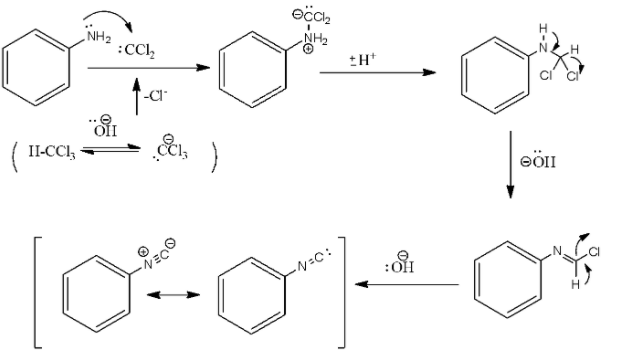Answer
34.5k+ views
Hint: Carbylamine reaction is used as a test for the identification of primary amines. This test is also referred to as a Saytzeff's isocyanide test. This reaction cannot be used for the identification of secondary and tertiary amines.
Complete step by step answer:
When we heat aliphatic and aromatic primary amines in presence of ethanolic potassium hydroxide and chloroform, carbylamines or isocyanides are generated. The carbylamines have an unpleasant odour. Secondary and tertiary amines do not respond to this carbylamine reaction test.

The mechanism of the carbylamine reaction is given as:

In the above reaction, the addition of the amine to the dichlorocarbene, which is a reactive intermediate that is generated by the chloroform dehydrohalogenation. The formation of the isocyanide involves two successive base-mediated dehydrochlorination.
Additional information:
Carbylamine reaction helps us in testing and distinguish primary amine from that of the secondary and the tertiary amines. We need two protons in this reaction which are provided by the primary amines, but the secondary and the tertiary amines do not give two protons, so they do not show this carbylamine test. Also, secondary and tertiary amines do not form the isocyanides when they are made to undergo the carbylamine reaction, as they have more than one alkyl group that hinders the approach of the group.
Note:
Students may get confused regarding which amine will respond to the carbylamine test. It is important to note that only primary amines respond to this reaction. Secondary and tertiary amines do not respond to the carbylamine reaction.
Complete step by step answer:
When we heat aliphatic and aromatic primary amines in presence of ethanolic potassium hydroxide and chloroform, carbylamines or isocyanides are generated. The carbylamines have an unpleasant odour. Secondary and tertiary amines do not respond to this carbylamine reaction test.

The mechanism of the carbylamine reaction is given as:

In the above reaction, the addition of the amine to the dichlorocarbene, which is a reactive intermediate that is generated by the chloroform dehydrohalogenation. The formation of the isocyanide involves two successive base-mediated dehydrochlorination.
Additional information:
Carbylamine reaction helps us in testing and distinguish primary amine from that of the secondary and the tertiary amines. We need two protons in this reaction which are provided by the primary amines, but the secondary and the tertiary amines do not give two protons, so they do not show this carbylamine test. Also, secondary and tertiary amines do not form the isocyanides when they are made to undergo the carbylamine reaction, as they have more than one alkyl group that hinders the approach of the group.
Note:
Students may get confused regarding which amine will respond to the carbylamine test. It is important to note that only primary amines respond to this reaction. Secondary and tertiary amines do not respond to the carbylamine reaction.
Recently Updated Pages
If a wire of resistance R is stretched to double of class 12 physics JEE_Main

The path difference between two waves for constructive class 11 physics JEE_MAIN

What is the difference between solvation and hydra class 11 chemistry JEE_Main

IfFxdfrac1x2intlimits4xleft 4t22Ft rightdt then F4-class-12-maths-JEE_Main

Sodium chloride is purified by passing hydrogen chloride class 11 chemistry JEE_Main

Hydrogen readily combines with nonmetals and thus it class 12 chemistry JEE_Main

Other Pages
The resultant of vec A and vec B is perpendicular to class 11 physics JEE_Main

Oxidation state of S in H2S2O8 is A 6 B 7 C +8 D 0 class 12 chemistry JEE_Main

Explain the construction and working of a GeigerMuller class 12 physics JEE_Main

Two identical charged spheres suspended from a common class 12 physics JEE_Main

If a wire of resistance R is stretched to double of class 12 physics JEE_Main

Iodoform can be prepared from all except A Acetaldehyde class 12 chemistry JEE_Main



